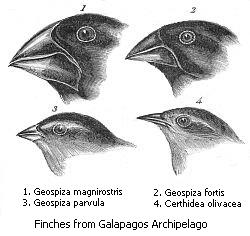Divergent evolution
Accumulation of differences between closely related species populations, leading to speciation From Wikipedia, the free encyclopedia
Divergent evolution or divergent selection is the accumulation of differences between closely related populations within a species, sometimes leading to speciation. Divergent evolution is typically exhibited when two populations become separated by a geographic barrier (such as in allopatric or peripatric speciation) and experience different selective pressures that cause adaptations. After many generations and continual evolution, the populations become less able to interbreed with one another.[1] The American naturalist J. T. Gulick (1832–1923) was the first to use the term "divergent evolution", with its use becoming widespread in modern evolutionary literature.[2] Examples of divergence in nature are the adaptive radiation of the finches of the Galápagos, changes in mobbing behavior of the kittiwake, and the evolution of the modern-day dog from the wolf.

The term can also be applied in molecular evolution, such as to proteins that derive from homologous genes. Both orthologous genes (resulting from a speciation event) and paralogous genes (resulting from gene duplication) can illustrate divergent evolution. Through gene duplication, it is possible for divergent evolution to occur between two genes within a species. Similarities between species that have diverged are due to their common origin, so such similarities are homologies.[3]
Causes
Animals undergo divergent evolution for a number of reasons linked to changes in environmental or social pressures. This could include changes in the environment, such access to food and shelter.[4] It could also result from changes in predators, such as new adaptations, an increase or decrease in number of active predators, or the introduction of new predators.[5] Divergent evolution can also be a result of mating pressures such as increased competition for mates or selective breeding by humans.[6]
Distinctions
Summarize
Perspective
Divergent evolution is a type of evolution and is distinct from convergent evolution and parallel evolution, although it does share similarities with the other types of evolution.[7]
Divergent versus convergent evolution
Convergent evolution is the development of analogous structures that occurs in different species as a result of those two species facing similar environmental pressures and adapting in similar ways. It differs from divergent evolution as the species involved do not descend from a closely related common ancestor and the traits accumulated are similar.[4] An example of convergent evolution is the development of flight in birds, bats, and insects, all of which are not closely related but share analogous structures allowing for flight.[8]
Divergent versus parallel evolution
Parallel evolution is the development of a similar trait in species descending from a common ancestor. It is comparable to divergent evolution in that the species are descend from a common ancestor, but the traits accumulated are similar due to similar environmental pressures while in divergent evolution the traits accumulated are different.[9] An example of parallel evolution is that certain arboreal frog species, 'flying' frogs, in both Old World families and New World families, have developed the ability of gliding flight. They have "enlarged hands and feet, full webbing between all fingers and toes, lateral skin flaps on the arms and legs, and reduced weight per snout-vent length".[10]
Darwin's finches
One of the first recorded examples of divergent evolution is the case of Darwin's Finches. During Darwin's travels to the Galápagos Islands, he discovered several different species of finch, living on the different islands. Darwin observed that the finches had different beaks specialized for that species of finches' diet.[11] Some finches had short beaks for eating nuts and seeds, other finches had long thin beaks for eating insects, and others had beaks specialized for eating cacti and other plants.[12] He concluded that the finches evolved from a shared common ancestor that lived on the islands, and due to geographic isolation, evolved to fill the particular niche on each of the islands.[13] This is supported by modern day genomic sequencing.[14]
Divergent evolution in dogs
Another example of divergent evolution is the origin of the domestic dog and the modern wolf, who both shared a common ancestor.[15] Comparing the anatomy of dogs and wolves supports this claim as they have similar body shape, skull size, and limb formation.[16] This is even more obvious in some species of dogs, such as malamutes and huskies, who appear even more physically and behaviorally similar.[17] There is a divergent genomic sequence of the mitochondrial DNA of wolves and dogs dated to over 100,000 years ago, which further supports the theory that dogs and wolves have diverged from shared ancestry.[18]
Divergent evolution in kittiwakes
Another example of divergent evolution is the behavioral changes in the kittiwake as opposed to other species of gulls. Ancestorial and other modern-day species of gulls exhibit a mobbing behavior in order to protect their young due the nesting at ground-level where they are susceptible to predators.[19] As a result of migration and environmental changes, the kittiwake nest solely on cliff faces. As a result, their young are protected from predatory reptiles, mammals, and birds who struggle with the climb and cliff-face weather conditions, and they do not exhibit this mobbing behavior.[20]
Divergent evolution in cacti
Another example of divergent evolution is the split forming the Cactaceae family approximately dated in the late Miocene. Due to increase in arid climates, following the Eocene–Oligocene event, these ancestral plants evolved to survive in the new climates.[21] Cacti evolved to have areoles, succulent stems, and some have light leaves, with the ability to store water for up to months.[22] The plants they diverged from either went extinct leaving little in the fossil record or migrated surviving in less arid climates.[23]
See also
References
Further reading
Wikiwand - on
Seamless Wikipedia browsing. On steroids.
